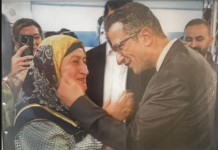After the AKP declared in November 2013 that the Turkish cram-school sector would be shuttered (later the exact closure date was announced as 1 September 2015), media organs connected to Gülen immediately began a full-scale assault on the AKP and (then PM) Tayyip Erdoğan. Over the previous years Zaman had published articles, or even op-eds from Fethullah Gülen, that were critical of the AKP, but what occurred in relation to the cram-school issue was totally unprecedented. Venomous hatred began to gush from the front pages of Zaman and Bugün.
I had expected resistance from Gülen’s organization to legislative steps curbing the cram-school sector, but I didn’t expect the intensity of the reaction. I assumed that Gülen would accept the socio-political reality in Turkey and find ways to adjust his organization to the socio-political reality. After all, his motto was “service” (hizmet), right? I took that slogan at face value, and believed that Gülen was more devoted to the social service aspect of his organization’s activities than to profit-making. There were a variety of options for his cram-schools; they could be re-oriented to other efforts, or turned into public schools, for example.
I was greatly mistaken in expecting Gülen to react rationally to developments in Turkish society and politics, but I still have not entirely understood exactly why he chose the route that he did. Possibly he is simply mentally unbalanced. Those few authors who have known the organization from the inside, and then actually written about their experiences and put their knowledge on paper, indicate that Gülen has had a long-term plan (of 40-plus years) to subvert the Turkish state in revenge for the 1960 military coup. The intense, long-term nature of Gülen’s obsession suggests some sort of mania or psychosis. But it also highlights one of the original errors that Turkey’s military-state elites (1) have made in the past century. Using force to destroy a democratically-elected government cannot be justified, and the enduring consequences have always been severe. After each such coup, Turkish society has suffered decades of political disorder and violence.
A month after the announcement that the cram-school sector would be shut down, on 17th December 2013 Turkey woke up to a new political era as Gülen’s adherents in the Turkish police and the judiciary launched a major offensive against the government (2). As in February 2012, in the first few hours what exactly was happening was not clear, and would only become more understandable as the days passed. The notes that I took between 17 and 20 December 2013 state only that corruption investigations had been opened against several government ministers’ sons, as well as some leading businessmen like Reza Zarrab or Ali Ağaoğlu, plus some other public figures, though the seriousness of the charges and the points of origin of the background investigations were unclear.
Then a week later, i.e. on 25 December 2013, Gülenist prosecutors gifted everyone with another wave of corruption cases. It was nothing short of a much more overt and direct attempt at overthrowing the government. Part of it was played out at the Istanbul Police Headquarters in the Aksaray neighborhood. As special Gülenist police teams, armed with search-and arrest warrants again issued by Gülenist judges or procurators, were about to leave the Security Directorate precinct to head for various top-secret destinations, they were stopped at the nth minute by other, regular forces loyal to the elected government. The rest of the furore took place on social media, especially Twitter. On the day, the Turkish press or media gave only marginal attention to it, and even Zaman did not devote its main headlines on 26 December 2016 to those cases (4).
In later weeks, we gradually learned that these so-called corruption files had been put together by Gülen’s police and prosecutors well before December 2013, in some cases even more than a year before. Hundreds of legal and illegal wiretap warrants had been granted to Gülenist police and prosecutors by other Gülenists higher up in order for them to collect (or manufacture) “evidence” for the cases. It became obvious that the prosecutors had been acting not out of purely legal but massively political concerns — as they had been waiting and biding their time to open these cases for some specific purpose, apparently so as to maximize their political repercussions.
Even today the contents and “quality” of these cases is still an open question. Similar to the Ergenekon and Balyoz cases, some of the “evidence” was either obtained illegally or simply fabricated. On the other hand, and again like the Ergenekon and Balyoz cases, there does seem to have been a germ of truth to their essential claims. The fact that the four ministers involved eventually resigned under pressure, and that only one, Egeman Bağış, has managed to re-enter public life (to some extent), suggests that the accusations against them were not entirely hollow. But the overtly political nature of the entire initiative ensured that the vast majority of the Turkish public would never grant them credibility to any great extent.
These 17-25 December 2013 corruption cases’ political overtones and implications is also why Turkish politics turned on a dime in that critical month of December 2013. Growing suspicions turned overnight into concrete reality, and political allegiances rotated 180 degrees in an instant, closely following the same socio-political lines that have always determined Turkish political allegiances. Many who had previously either supported Gülen’s organization or, at best, had not seen Gülen’s organization as a real threat, but who had also started harboring their doubts about Gülen’s motives and activities over the previous years, were now confronted with blatant confirmation of their betrayed trust and fears, and thus became his vigorous opponents. On the other hand, some others who had been vocal opponents of Gülen — both out of concern for their own socio-political status, and also hatred for the AKP — suddenly became Gülen’s allies and promoters. I witnessed people who had, for example, refused to buy Ülker products (or even stocks) — on the grounds that Murat Ülker was supposedly close to Gülen — suddenly begin saying, with disingenuous looks on their faces, that Gülen was “actually doing positive things,” and that Gülen was “helping spread Turkish culture.” This turn of events was both stunning and abhorrent.
NOTES
(*) This article picks up from where I left off in early November, just before the U.S. presidential election: https://serbestiyet.com/yazarlar/adam-mcconnel/gulens-cult-6-how-in-2012-13-his-followers-helped-the-syrian-civil-war-reach-turkey-733290
(1) The Gramscian “historical bloc” in Hasan Bülent Kahraman’s Türk Siyasetinin Yapısal Analizi (A Structural Analysis of Turkish Politics).
(2) In retrospect, the late-November 2013 provision of a Turkish National Security Council (Milli Güvenlik Kurulu) document to the daily Taraf, which purportedly showed that the AKP was forging an alliance with the Turkish military to attack the Gülenist cult, should be understood as a warm-up for what happened a couple weeks later. The author associated with Taraf’s original article, Mehmet Baransu, was the principal Gülenist provider of “secret” documents, authentic or tampered with or entirely forged, to Taraf, and is currently in prison: http://www.sozcu.com.tr/2013/gundem/guleni-bitirme-karari-2004-mgkda-alindi-414756/; http://www.hurriyet.com.tr/guleni-bitirme-iddiasina-ak-partiden-art-arda-aciklamalar-25228969.
(3) http://www.ntv.com.tr/galeri/turkiye/gunun-gazete-mansetleri-26-aralik-2013,d85HlOqbcUa-orcGh3vGOw.













